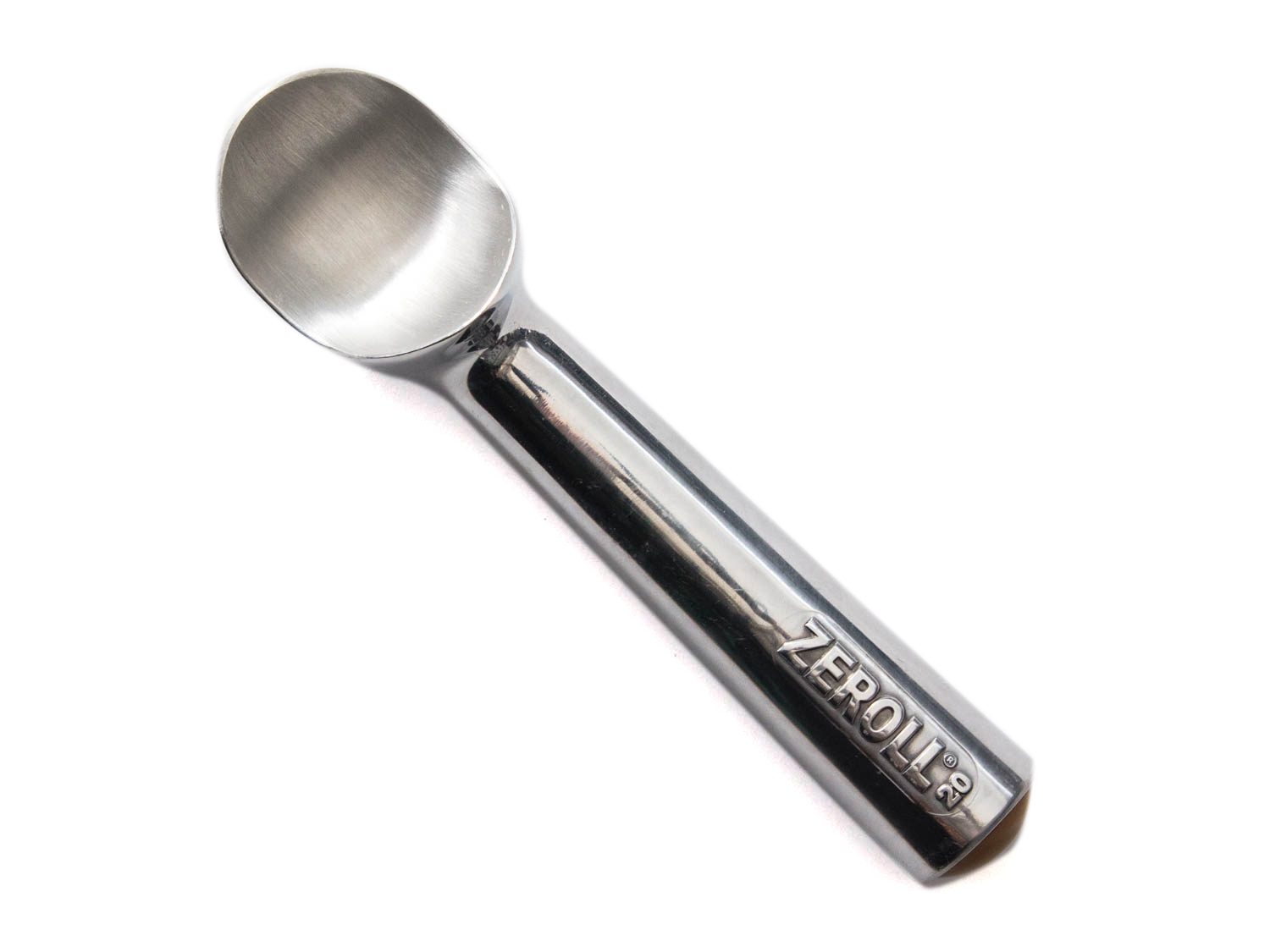
[Photographs: Vicky Wasik]
We’ve all been there: The craving for ice cream hits, so you grab a spoon and start digging into a pint, hoping to transfer a mound of mint chocolate chip into your bowl. But the spoon bends, hurting your hand in the process, and the hard ice cream remains unmoved.
Let’s not be those people anymore. An ice cream scoop is sturdier than just about any other utensil in your kitchen. It’s also more comfortable to use, and it has a bowl designed to turn frozen dairy into picture-perfect spheres. Whether you buy pints from the supermarket or take the time to make your own at home, you’ll want to serve your ice cream from a scoop that helps you nail that iconic presentation.
We rounded up 17 models, ranging from around $5 to $35, and put them through scooping tests to find the shape and design that work best.
Our Favorite, at a Glance
The Best Ice Cream Scoop: Zeroll Original Ice Cream Scoop
The Zeroll ice cream scoop’s shape has changed little since it came out in 1935, and for good reason. Inside the comfortable one-piece design is a food-safe liquid that transfers heat from your hand to the bowl, making it easier to form tidy ice cream mounds. With no moving parts, the scoop should last for years—just be sure to clean it by hand, as it’s not dishwasher-safe. Because the Zeroll’s bowl and handle are symmetrical, it works equally well for righty and lefty users.
The Criteria: What We Look for in a Great Ice Cream Scoop
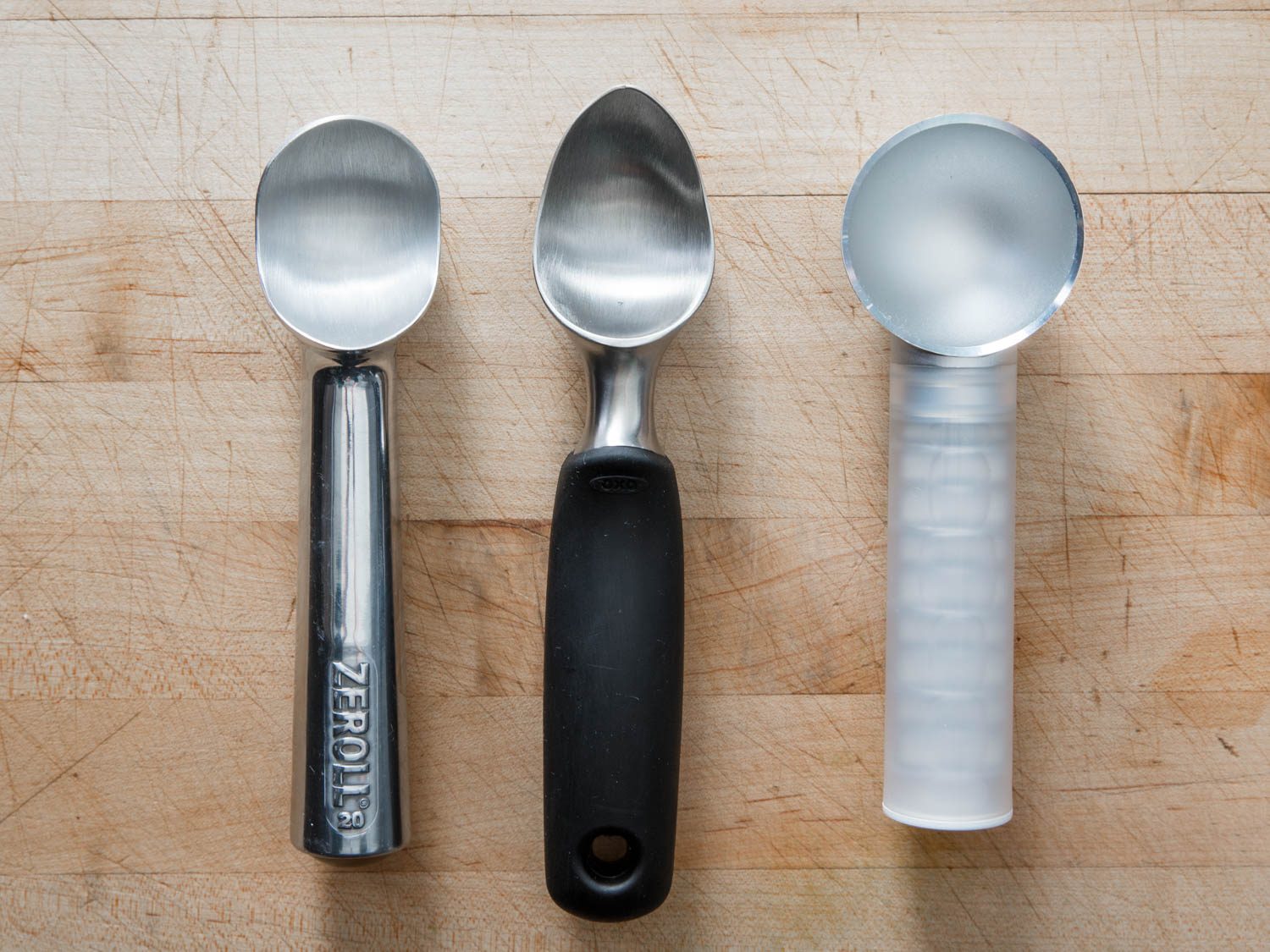
The bowl shapes on the scoops we tested ranged from oval to shovel-shaped to round. Testers found it easier to scoop from tools with oval bowls.
To justify the purchase of this unitasker, an ice cream scoop should dole out the dairy with far less effort than it takes using a common spoon. A good scoop won’t flex or break, even when plowing through the hardest pint. The bowl’s design should cut through the ice cream easily and curl it into a pleasing ball as you finish the scooping motion. The goal isn’t just to get the ice cream out—you can do that with a butter knife, or by jamming your face into the pint—but to do so with relative ease, and to mold it into a nice shape for your Instagram-worthy three-scoop sundae. A scoop allows you to serve consistently sized portions, avoiding the mashup of ice cream shards and massive icebergs you get with a regular spoon. The bowl should release the payload without requiring an excessive amount of flicking, and it shouldn’t leave chunks of your ice cream clinging to it. Digging out ice cream can be hard work, so the handle has to be comfortable, too.
There are three popular styles of ice cream removal tools: the scoop, the disher, and the spade. While researching which models to test, we noticed a nearly universal preference for one-piece scoops, like our winner. Reviewers commonly complain that disher-style designs—distinguished by the metal sweeper bar that clears the ice cream out of the inside of the bowl—are strenuous to use, and that the mechanical parts can become hard to move over time. They’re also hand-specific, so lefties have a hard time using scoops designed for righties. Meanwhile, spades usually won’t break down, but they have wide, flat ends that make them impractical when you’re scooping from narrow pints. They’re a better choice if you work in a gelato shop, serving from big tubs of soft ice cream. While we tested some dishers and spades, we focused on scoops.
The bowl shapes we tested ranged from round to oval to ones that look like a shovel. Overall, we found that oval bowls did a better job of curling the ice cream onto itself. There were some round-bowl models that formed nice scoops, but they were uncomfortable to use because their wide heads created more resistance as you dug into the ice cream. The handles on these tools can be solid or hollow; some are covered in grippy rubber. Our winning model is made of hollow, conductive aluminum and filled with a liquid that helps warm the bowl, which makes it easier to scoop hard ice cream. Testers also gravitated toward lightweight aluminum tools over the heavier-duty solid stainless steel models.
To select specific models to test, we cross-referenced reviews on Amazon, America’s Test Kitchen (subscription required), Consumer Reports (subscription required), The Wirecutter, Food & Wine, The Kitchn, and Epicurious.
The Testing
Scooping Ice Cream
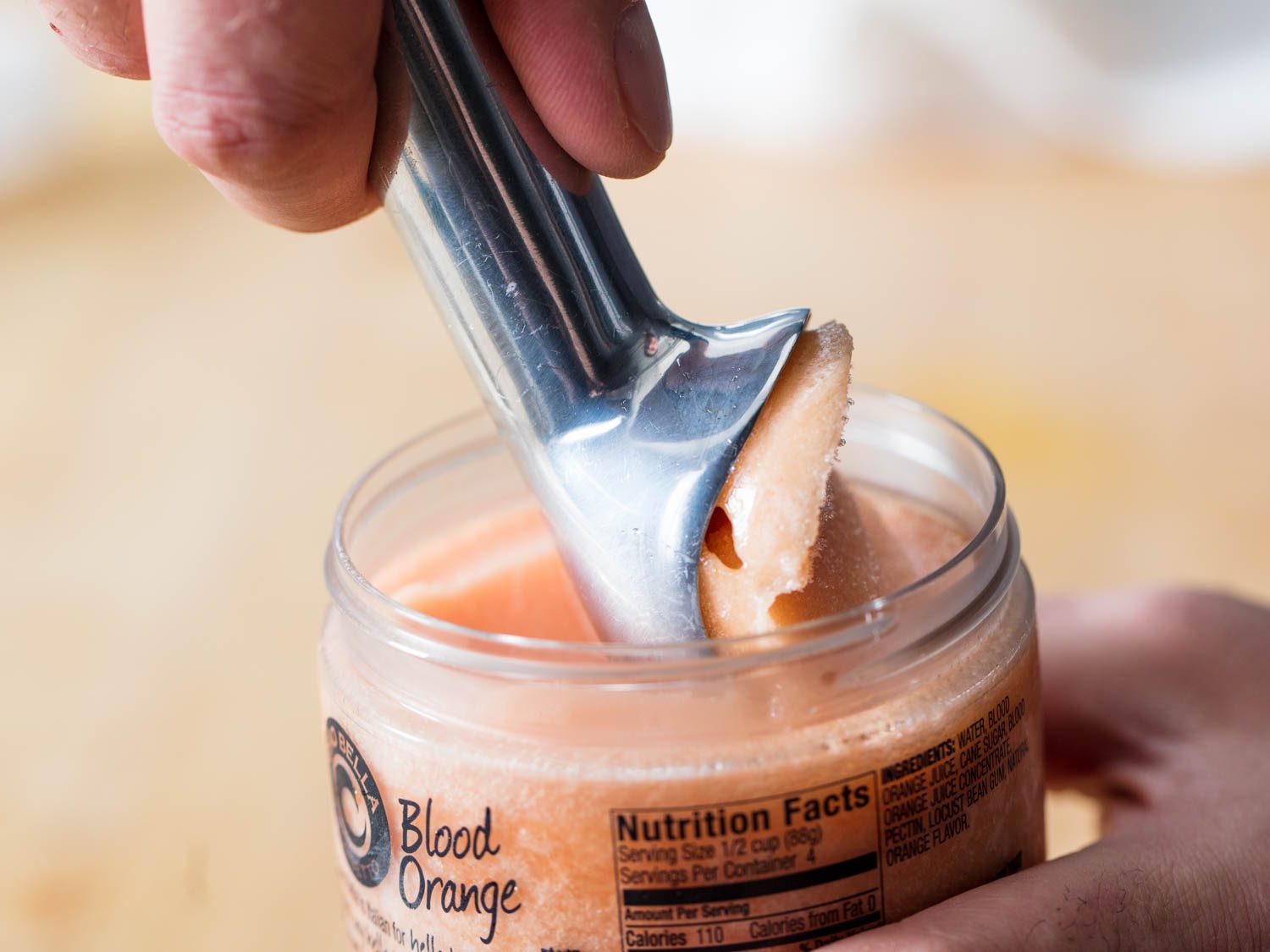
Our favorite ice cream scoop has a comfortable, round handle.
A good ice cream scoop makes it easier to form rounded mounds from a variety of frozen desserts in a range of containers. We tested with pints of “super-premium” chunky ice creams, like Ben & Jerry’s Chocolate Chip Cookie Dough and Häagen-Dazs’s Rocky Road, as well as one-and-a-half-quart tubs of smoother, “premium” Turkey Hill French Vanilla and Friendly’s Chocolate Almond Chip. We also scooped from pint-sized containers of Ciao Bella’s Blood Orange Sorbetto.
These ice creams offered a range of textures and densities for our scooping tests. “Super-premium” ice creams feel firmer out of the freezer than other brands because they’re denser. The density is largely determined by “overrun,” which is ice cream industry lingo for the amount of air incorporated into the product during churning. Higher overrun means more air is trapped in the ice cream, making it easier to scoop and portion. “Super-premium ice cream is around 20 to 30% overrun, while premium brands are around 80 to 100%,” says Professor Robert Roberts, head of the food science department at Penn State University.
We lined up four testers, a mix of righties and lefties, with varying hand sizes and strengths. Testers scooped two or three times from containers of ice cream using the tools, emptying the portions into pint containers or onto sugar cones. As testers evaluated the scoops, we recorded their observations on the shape of the ice cream portion, how comfortable the handle was, and how easily the scoop released the ice cream.
The one-piece scoops with oval bowls performed the best and were the easiest to use. Testers preferred the simple design to models that released the ice cream mechanically using a sweeper bar or lever. Many of the scoops had an ambidextrous handle that was comfortable for both righty and lefty testers; in the end, we found that an unadorned, round shaft was the most pleasant to use.
Uniformity of the Scoop
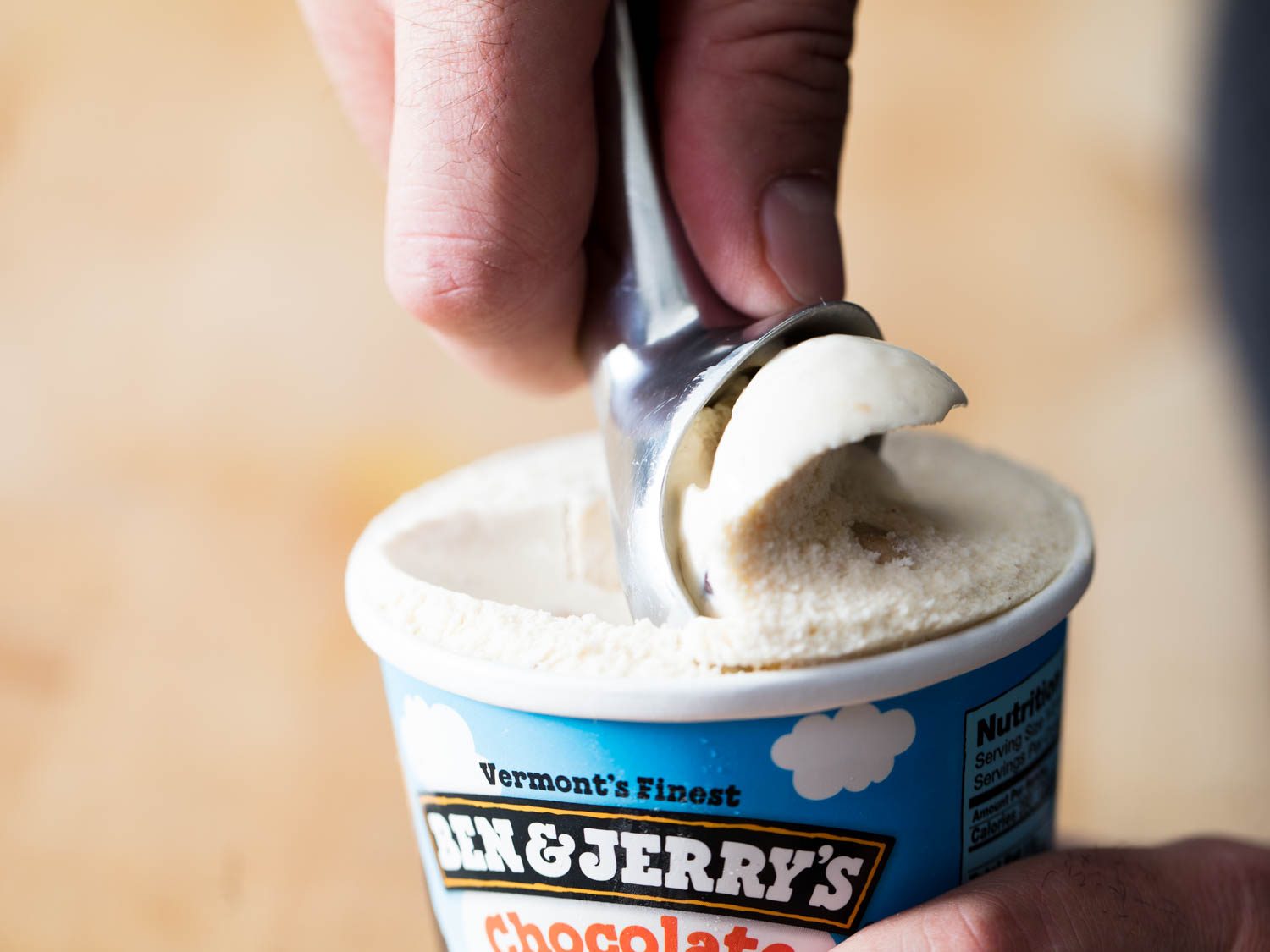
An oval bowl encourages the ice cream to curl in on itself, forming a nice round ball.
A scoop should be comfortable to use, of course, but it should also create round balls of ice cream. To test how well each model shaped ice cream, we scooped from a range of containers and awarded points to models that produced round orbs.
Testers had an easier time forming balls of ice cream using scoops with oval bowls, like our winning Zeroll. As mentioned earlier, the oval shape encourages the dairy to curl in on itself as you scrape across the ice cream. Shovel-shaped heads didn’t do nearly as well, requiring more effort to pack the ice cream into a ball. The disher-style scoops had round bowls that formed pleasant spheres, but the sweeper bar often left chunks of ice cream behind in the scoop, and some of the tools had uncomfortable handles. One model we tested, the Scoop That II, has a round head that forms nice spheres and a comfortable handle, but, with a big bowl of just over two inches wide, digging and pulling it across hard ice cream was strenuous.
We also set the scoops onto standard sugar cones to see if any of the models produced portions that were too large or small. Most of the scoops turned out a portion that was about the same size as the cone’s opening, or slightly larger. Nearly all of the scoops we tested had bowls that produced a two- to three-ounce portion, which is about the right size for a standard serving of ice cream in two or three scoops. Many pro-style scoops, like the Zeroll and disher scoops, have color-coded handles with numbers stamped on them indicating the size of the portion they yield. That number in turn indicates how many portions the tool can make from a quart or gallon of ice cream, which can range from 60 small orbs to 20 massive balls. (Importantly, though, the number on the handle is not equivalent to the number of portions the scoop can get out of a quart or gallon.) Our winning Zeroll is a #20 scoop, which means it gets 40 portions from a gallon of ice cream.
Ease of Release
A perfect scoop of ice cream can be ruined by a bowl that doesn’t release cleanly. Testers noted how easily each scoop dropped the ice cream into an empty quart container.
The better models let go of the ice cream quickly, without leaving much behind in the bowl and without requiring excessive shaking. Our winning Zeroll didn’t take much effort to drop the ice cream and wasn’t noticeably grippier than the company’s nonstick-coated model. The disher-style and shovel-shaped scoops left more ice cream behind than the tools with oval bowls, which released without much fuss.
Handle Shape and Material
Digging out ice cream, especially that first scoop from a rock-hard pint, isn’t always pretty. You’re less likely to notice the difficulty if the handle is robust and comfortable. The handles on our test models ranged from bare metal to hard plastic to rubbery grips surrounding solid metal. Both lefty and righty testers used the scoops and scored them on comfort.
Testers found rubber handles comfortable, but, oddly enough, every model with a rubber handle also had a shovel-shaped bowl, which is harder to use. The most expensive model we tested, the Midnight Scoop, has a solid stainless steel body that’s hefty and balanced—unfortunately, it’s too easy to push the ice cream, rather than scoop and round it. Our winner sports a smooth handle that’s about three and a half inches in circumference, which was comfortable for most of the testers. The Good Cook model has a bowl that splits apart when you release the handles; while it formed nice balls of ice cream and released them easily, testers didn’t like having to squeeze the handles closed while scooping hard ice cream. Our testers complained about handle comfort with disher-style scoops, too.
How We Chose Our Winner
While all the models we tested will get your favorite flavor out of a container and onto a cone, our winning scoop makes it easier to serve the hardest, chunkiest ice cream without straining your wrist.
The Best Ice Cream Scoop: Zeroll Original Ice Cream Scoop
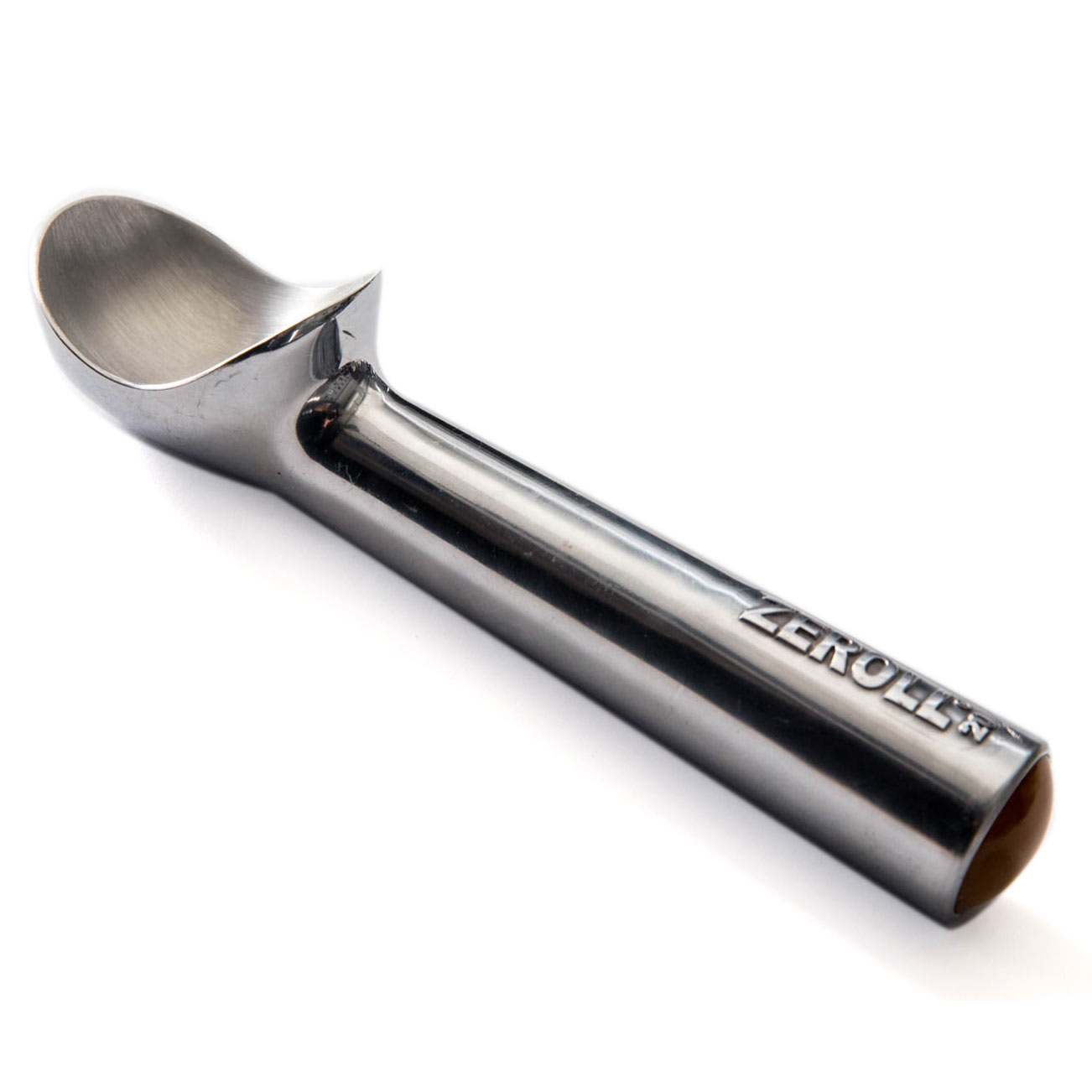
The Zeroll is a nearly indestructible classic that sees heavy use in ice cream shops. With little effort, the bowl’s oval shape curls ice cream into a ball, and the neat orbs roll out of the scoop easily without much shaking. The one-piece, lightweight aluminum design includes a handle filled with a food-safe mineral oil that helps transfer heat from your hand to the bowl, making it easier to cut through frozen ice cream. During testing, the models that featured the same design generally tended to make scooping easier.
To test the heat-transfer claims, we submerged the head of the Zeroll, and another model with the same design feature, into a bath of salt and ice that was -5°F (-21°C). After letting them chill for five minutes, we yanked them out, taped thermocouples to the centers of the bowls, and held them for five minutes while recording the temperatures. The test showed that the bowls on both scoops warmed up to around 73°F (23°C), which was warmer than the ambient room temperature at the time of the test. While you have to hold the scoop for a minute or so for the heat to kick in, the warmer bowl, combined with the narrow, oval shape, makes it easier to melt a path through the ice cream.
Most of the Amazon complaints about the Zeroll come from people who washed the scoop in the dishwasher. The manufacturer suggests hand-washing because the aluminum can react with the high heat and chemical detergent in a dishwasher, which can lead to discoloration or pitting (as it would with an aluminum baking sheet). Instead, clean it by hand with a mild soap and let it dry, and it should last years. Both lefty and righty testers commented that the Zeroll’s plain shaft was comfortable and balanced.
The Competition
A few quick notes on the other scoops we tested:
- The Zeroll nonstick-coated model is slightly more expensive than our winner, and, while it scoops just as well, we don’t think it releases the ice cream with noticeably more ease. After a few days of use and washing in the sink with the rest of the models, the handle had a few nicks in the finish, which doesn’t look great.
- The spade on the Zeroll Tubmate is two and five-eighths inches wide, making it difficult to work with in smaller, pint-sized containers.
- The New Star scoop is a copy of our winning Zeroll’s design, and its handle is also filled with a liquid that transfers heat from your hand to the scoop. (The manufacturer would not identify the liquid.) It ranked just behind the Zeroll in our tests, but we think our winner is a better scoop, though it costs a little more.
- The Scoop That II Warming Ice Cream Scoop was the best-performing round-bowl scoop we tested. It also features a liquid in the handle that helps warm the bowl (though, again, the manufacturer wouldn’t provide specifics). We liked the sharp cutting edge around the bowl, which made it easy to form balls of softer ice cream. But with really hard ice cream, it’s hard to dig the large head—which is more than two inches wide—into the carton.
- The OXO Good Grips Solid Stainless Steel Ice Cream Scoop and the SUMO are nearly identical, with the same robust build, shovel-like bowl, and comfy grip, but both are plagued by the same issue: They’re simply too heavy. Testers also had a hard time getting the ice cream to curl into a pleasing ball.
- Another OXO model, the Steel, has an almost perfectly round bowl with a lever that ejects the scoop. The ice cream sometimes stuck to the lever, and, with a bowl that’s more than two inches wide, scooping hard, “super-premium” brands was challenging.
- The Good Cook Smart Scoop releases ice cream very easily, thanks to the nonstick coating and a bowl that separates into two halves. But the innovative design forces you to squeeze the handles closed while scooping, which is uncomfortable with hard ice cream.
- Another model from Good Cook, the Twister, requires turning your wrist as you dig down into the ice cream. During testing, it was difficult to form a true ball of ice cream, and the twisting motion is awkward.
- The pricey Midnight Scoop looks like a piece of modern sculpture. To use it, you push with the palm of your hand, rather than pulling, like with a traditional scoop. There’s a bit of a learning curve to use it correctly; for us, it pushed the ice cream like a bulldozer, never really scooping it. This ergonomic model also needs a wide-open area to work in, so, if you buy ice cream in narrow pint or quart containers, this probably isn’t the right tool for you.
- The Wilton scoop looks like a hammerhead shark, with wings that work well at getting into every area inside a container of ice cream. It’s comfortable, with a nice weight, but it doesn’t do well at forming balls of ice cream.
- The design and feel of the Norpro is very similar to that of our winner, but the oval bowl tapers as it nears the handle. That small change results in a scoop of ice cream that looks more like a narrow disk than a round mound.
- The Solula is Amazon’s best-selling disher-style scoop as of the time of testing. While it’s well built, ice cream clings to the bowl, and the #40-size scoop we tested is too small, making portions that fell into the depths of a sugar cone.
- Another Amazon top seller, the KitchenAid has a narrow bowl that easily works between the ice cream and the container, but it forms more of an egg-shaped scoop, and many users complained about the chrome finish pitting and flaking off.
- The dimples on the bowl of the Joseph Joseph help release the ice cream easily, but the white collar, which is designed to catch runny drips as the scoop sits up on end, makes it harder to pull the tool tight against the side of the container and form a ball.
- The nice round scoops that came out of the Vollrath disher were about one and three-quarters inches in diameter, which was a bit too small for a sugar cone. But the real flaw was the thumb-actuated sweeper, which was uncomfortable to squeeze, even for testers with large hands.
Source link